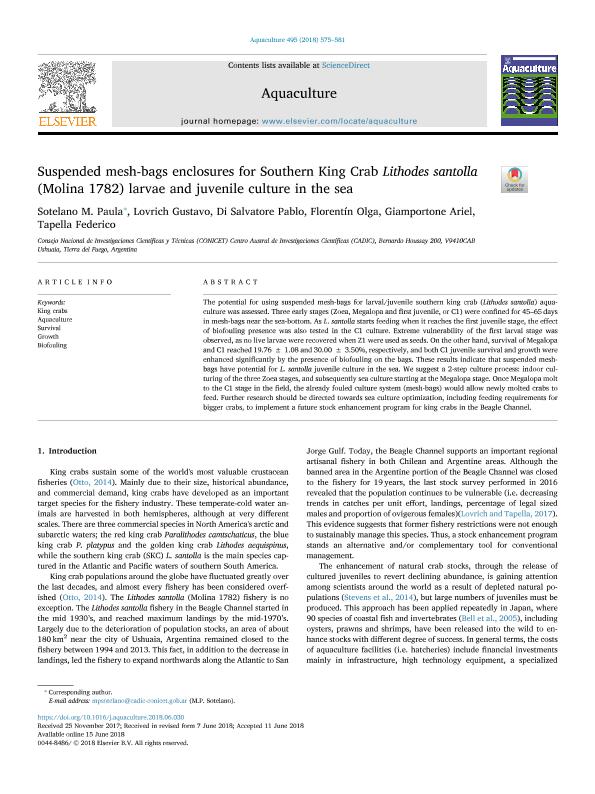Mostrar el registro sencillo del ítem
dc.contributor.author
Sotelano, María Paula

dc.contributor.author
Lovrich, Gustavo Alejandro

dc.contributor.author
Di Salvatore, Pablo

dc.contributor.author
Florentin, Olga Viviana

dc.contributor.author
Giamportone, Ariel Lujan

dc.contributor.author
Tapella, Federico

dc.date.available
2019-10-21T19:49:43Z
dc.date.issued
2018-10
dc.identifier.citation
Sotelano, María Paula; Lovrich, Gustavo Alejandro; Di Salvatore, Pablo; Florentin, Olga Viviana; Giamportone, Ariel Lujan; et al.; Suspended mesh-bags enclosures for Southern King Crab Lithodes santolla (Molina 1782) larvae and juvenile culture in the sea; Elsevier Science; Aquaculture; 495; 10-2018; 575-581
dc.identifier.issn
0044-8486
dc.identifier.uri
http://hdl.handle.net/11336/86725
dc.description.abstract
The potential for using suspended mesh-bags for larval/juvenile southern king crab (Lithodes santolla) aquaculture was assessed. Three early stages (Zoea, Megalopa and first juvenile, or C1) were confined for 45–65 days in mesh-bags near the sea-bottom. As L. santolla starts feeding when it reaches the first juvenile stage, the effect of biofouling presence was also tested in the C1 culture. Extreme vulnerability of the first larval stage was observed, as no live larvae were recovered when Z1 were used as seeds. On the other hand, survival of Megalopa and C1 reached 19.76 ± 1.08 and 30.00 ± 3.50%, respectively, and both C1 juvenile survival and growth were enhanced significantly by the presence of biofouling on the bags. These results indicate that suspended mesh-bags have potential for L. santolla juvenile culture in the sea. We suggest a 2-step culture process: indoor culturing of the three Zoea stages, and subsequently sea culture starting at the Megalopa stage. Once Megalopa molt to the C1 stage in the field, the already fouled culture system (mesh-bags) would allow newly molted crabs to feed. Further research should be directed towards sea culture optimization, including feeding requirements for bigger crabs, to implement a future stock enhancement program for king crabs in the Beagle Channel.
dc.format
application/pdf
dc.language.iso
eng
dc.publisher
Elsevier Science

dc.rights
info:eu-repo/semantics/openAccess
dc.rights.uri
https://creativecommons.org/licenses/by-nc-sa/2.5/ar/
dc.subject
AQUACULTURE
dc.subject
BIOFOULING
dc.subject
GROWTH
dc.subject
KING CRABS
dc.subject
SURVIVAL
dc.subject.classification
Biología Marina, Limnología

dc.subject.classification
Ciencias Biológicas

dc.subject.classification
CIENCIAS NATURALES Y EXACTAS

dc.title
Suspended mesh-bags enclosures for Southern King Crab Lithodes santolla (Molina 1782) larvae and juvenile culture in the sea
dc.type
info:eu-repo/semantics/article
dc.type
info:ar-repo/semantics/artículo
dc.type
info:eu-repo/semantics/publishedVersion
dc.date.updated
2019-10-17T13:54:48Z
dc.journal.volume
495
dc.journal.pagination
575-581
dc.journal.pais
Países Bajos

dc.journal.ciudad
Amsterdam
dc.description.fil
Fil: Sotelano, María Paula. Consejo Nacional de Investigaciones Científicas y Técnicas. Centro Austral de Investigaciones Científicas; Argentina
dc.description.fil
Fil: Lovrich, Gustavo Alejandro. Consejo Nacional de Investigaciones Científicas y Técnicas. Centro Austral de Investigaciones Científicas; Argentina
dc.description.fil
Fil: Di Salvatore, Pablo. Consejo Nacional de Investigaciones Científicas y Técnicas. Centro Austral de Investigaciones Científicas; Argentina
dc.description.fil
Fil: Florentin, Olga Viviana. Consejo Nacional de Investigaciones Científicas y Técnicas. Centro Austral de Investigaciones Científicas; Argentina
dc.description.fil
Fil: Giamportone, Ariel Lujan. Consejo Nacional de Investigaciones Científicas y Técnicas. Centro Austral de Investigaciones Científicas; Argentina
dc.description.fil
Fil: Tapella, Federico. Consejo Nacional de Investigaciones Científicas y Técnicas. Centro Austral de Investigaciones Científicas; Argentina
dc.journal.title
Aquaculture

dc.relation.alternativeid
info:eu-repo/semantics/altIdentifier/doi/http://dx.doi.org/10.1016/j.aquaculture.2018.06.030
dc.relation.alternativeid
info:eu-repo/semantics/altIdentifier/url/https://www.sciencedirect.com/science/article/pii/S0044848617323293
Archivos asociados
